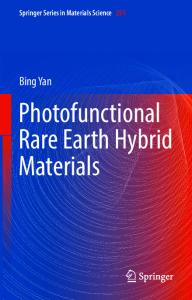Thermochemistry of Rare Earth Perovskites
- PDF / 320,314 Bytes
- 6 Pages / 432 x 648 pts Page_size
- 80 Downloads / 429 Views
Thermochemistry of Rare Earth Perovskites Dawei Feng and Alexandra Navrotsky* Peter A. Rock Thermochemistry Laboratory and NEAT ORU, University of California, Davis, One Shields Avenue, Davis, CA 95616, United States *Corresponding author email address: [email protected] (A. Navrotsky). Tel.: (530) 752-3292; fax: (530) 752-9307 Abstract The rare earth (RE) mineral loparite with the chemical composition (RE, Na, Sr, Ca)(Ti, Nb, Ta, Fe+3)O3 is the principal ore of the light rare earth elements (LREE) as well as niobium and tantalum. The enthalpies of formation of RE0.67-xNa3xTiO3 (RE = La, Ce) and Ca12xNaxLaxTiO3 from oxides and elements of lanthanum and cerium perovskites and their solid solutions have been obtained using high temperature oxide melt solution calorimetry. RE0.67xNa3xTiO3 (RE = La, Ce) perovskites become more stable relative to oxide components as sodium content increases. Na0.5Ce0.5TiO3 and Na0.5La0.5TiO3 can be considered stable endmembers in natural loparite minerals. For perovskite solid solutions Ca1-2xNaxLaxTiO3, the ι enthalpies of formation from the constituent oxides ο ǡ୭୶ become more exothermic with increasing Na+La content, suggesting a stabilizing effect of the substitution 2Ca2+ → Na+ + La3+ on the perovskite structure. The trend of increasing thermodynamic stability with decreasing structural distortion is similar to that seen in many other ABO3 perovskites. Introduction All elements used in technology come from the Earth, mainly from the minerals in rocks. This truism, obvious to geochemists, petrologists, and economic geologists, has not, until recently, been on the “radar screen” of the materials community. The skyrocketing price and potentially limited access to industrially critical rare earths (RE), used in small but essential amounts in lasers, displays, cell phones, magnets, and computers has brought “strategic” elements into the geopolitical arena [1]. Thermodynamic data for rare earth minerals are needed to understand all steps of the industrial rare earth cycle – prospecting, mining, extraction, assembling devices, assessing device lifetime and degradation, recycling, and disposal. The beginning and end of the cycle involve the earth sciences. A major issue in China and elsewhere is to reduce pollution and environmental damage associated with RE mining and processing. Better understanding of rare earth thermodynamics is needed to meet this goal. The systematic decrease of ionic radius down the trivalent RE series (the lanthanide contraction), the variable and often large coordination number and irregular coordination polyhedra, and oxidation state anomalies for Ce, Eu, and possibly Pr all add fundamental crystal chemical interest in linking systematic variations in structure and thermodynamics. Lanthanides (4f electron shell being filled) often occur together with uranium and thorium, are analogues for actinides (5f) and are themselves fission products, so understanding the solid state chemistry and thermodynamics of the RE is also relevant to the nuclear fuel cycle. Thus
Data Loading...











